Self-Sacrifice: Exploring Altruism in Psychology Essay
VerifiedAdded on 2022/11/22
|7
|1931
|311
Essay
AI Summary
This essay delves into the complex concept of self-sacrifice, also known as altruism, from a psychological perspective. It investigates whether altruistic behavior is an innate human quality, exploring this through the lenses of two key theories: Kin Selection and the Empathy-Altruism theory. The essay examines the social context of altruism, considering acts of giving and kindness often observed in religious and cultural settings, while also acknowledging the evolutionary perspective that questions the universality of self-sacrificial behavior. The Kin Selection theory is analyzed, focusing on altruism towards kin and its biological basis, while the Empathy-Altruism theory is examined in terms of emotional triggers like sympathy, compassion, guilt, and pity. The essay ultimately concludes that while humans exhibit variable levels of altruism, the idea of universal self-sacrifice is far-fetched, as sacrifices often have underlying motives. The essay uses references to support the arguments, and the content is perfect for students seeking to understand altruism from a psychological perspective.
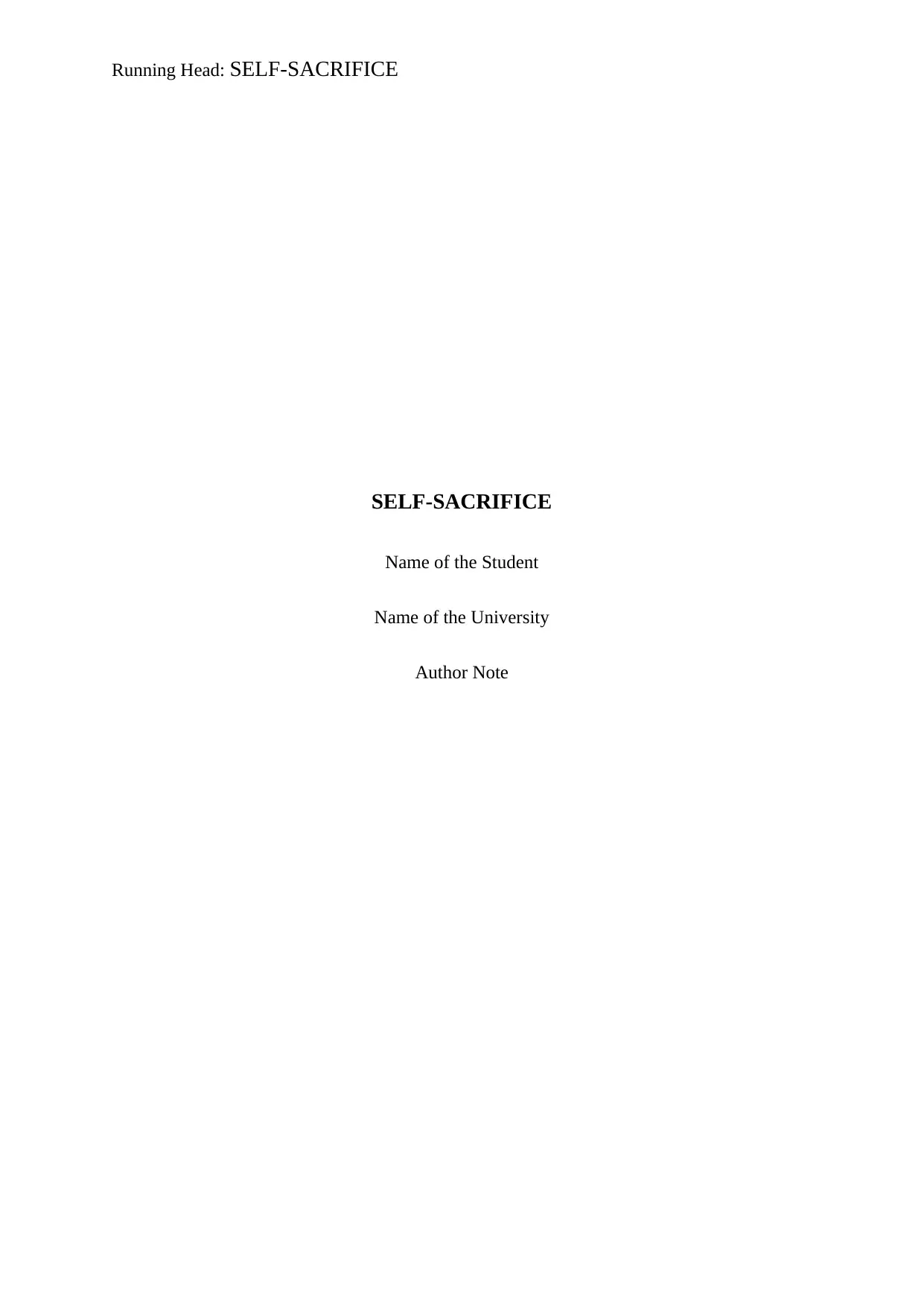
Running Head: SELF-SACRIFICE
SELF-SACRIFICE
Name of the Student
Name of the University
Author Note
SELF-SACRIFICE
Name of the Student
Name of the University
Author Note
Paraphrase This Document
Need a fresh take? Get an instant paraphrase of this document with our AI Paraphraser
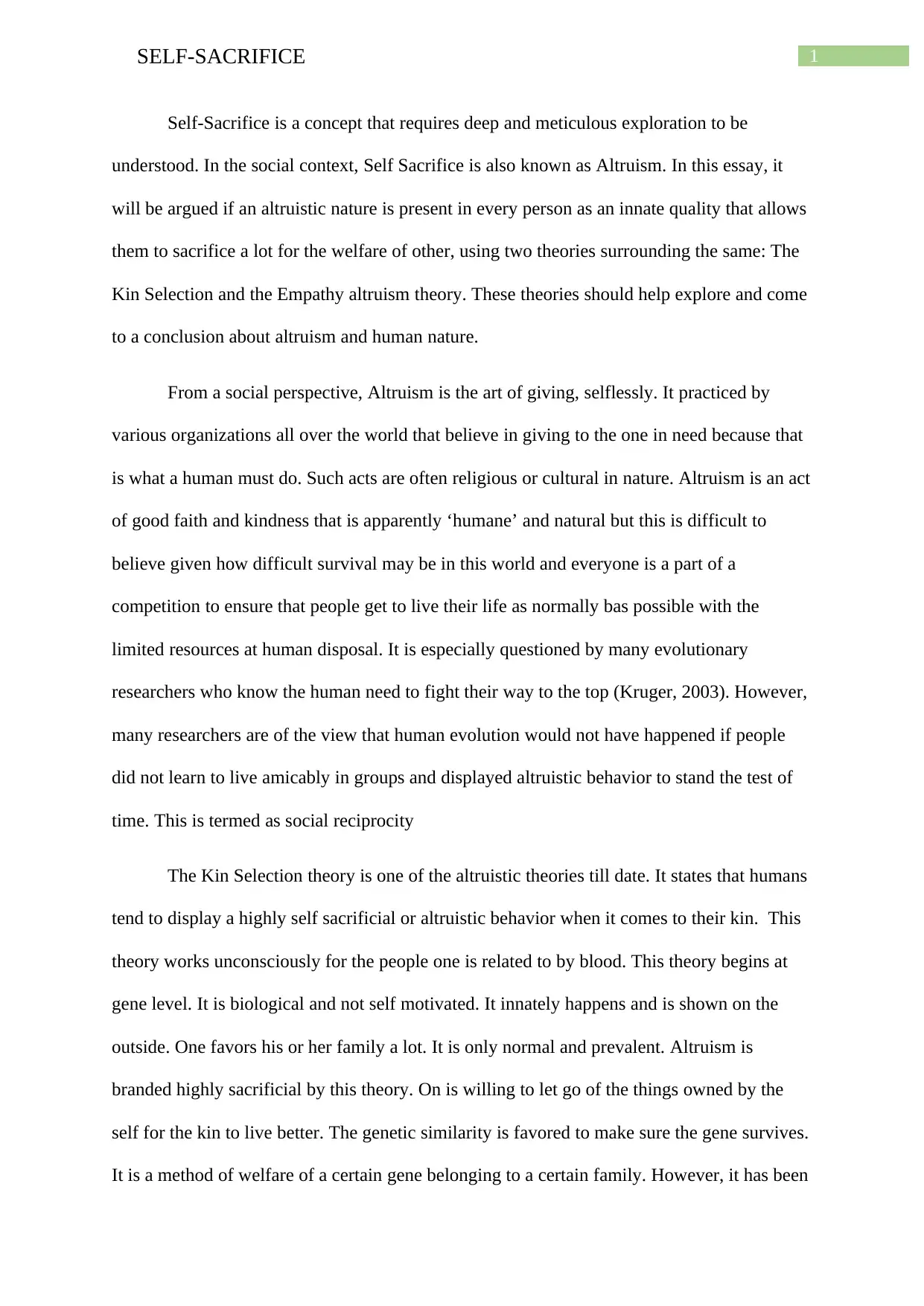
1SELF-SACRIFICE
Self-Sacrifice is a concept that requires deep and meticulous exploration to be
understood. In the social context, Self Sacrifice is also known as Altruism. In this essay, it
will be argued if an altruistic nature is present in every person as an innate quality that allows
them to sacrifice a lot for the welfare of other, using two theories surrounding the same: The
Kin Selection and the Empathy altruism theory. These theories should help explore and come
to a conclusion about altruism and human nature.
From a social perspective, Altruism is the art of giving, selflessly. It practiced by
various organizations all over the world that believe in giving to the one in need because that
is what a human must do. Such acts are often religious or cultural in nature. Altruism is an act
of good faith and kindness that is apparently ‘humane’ and natural but this is difficult to
believe given how difficult survival may be in this world and everyone is a part of a
competition to ensure that people get to live their life as normally bas possible with the
limited resources at human disposal. It is especially questioned by many evolutionary
researchers who know the human need to fight their way to the top (Kruger, 2003). However,
many researchers are of the view that human evolution would not have happened if people
did not learn to live amicably in groups and displayed altruistic behavior to stand the test of
time. This is termed as social reciprocity
The Kin Selection theory is one of the altruistic theories till date. It states that humans
tend to display a highly self sacrificial or altruistic behavior when it comes to their kin. This
theory works unconsciously for the people one is related to by blood. This theory begins at
gene level. It is biological and not self motivated. It innately happens and is shown on the
outside. One favors his or her family a lot. It is only normal and prevalent. Altruism is
branded highly sacrificial by this theory. On is willing to let go of the things owned by the
self for the kin to live better. The genetic similarity is favored to make sure the gene survives.
It is a method of welfare of a certain gene belonging to a certain family. However, it has been
Self-Sacrifice is a concept that requires deep and meticulous exploration to be
understood. In the social context, Self Sacrifice is also known as Altruism. In this essay, it
will be argued if an altruistic nature is present in every person as an innate quality that allows
them to sacrifice a lot for the welfare of other, using two theories surrounding the same: The
Kin Selection and the Empathy altruism theory. These theories should help explore and come
to a conclusion about altruism and human nature.
From a social perspective, Altruism is the art of giving, selflessly. It practiced by
various organizations all over the world that believe in giving to the one in need because that
is what a human must do. Such acts are often religious or cultural in nature. Altruism is an act
of good faith and kindness that is apparently ‘humane’ and natural but this is difficult to
believe given how difficult survival may be in this world and everyone is a part of a
competition to ensure that people get to live their life as normally bas possible with the
limited resources at human disposal. It is especially questioned by many evolutionary
researchers who know the human need to fight their way to the top (Kruger, 2003). However,
many researchers are of the view that human evolution would not have happened if people
did not learn to live amicably in groups and displayed altruistic behavior to stand the test of
time. This is termed as social reciprocity
The Kin Selection theory is one of the altruistic theories till date. It states that humans
tend to display a highly self sacrificial or altruistic behavior when it comes to their kin. This
theory works unconsciously for the people one is related to by blood. This theory begins at
gene level. It is biological and not self motivated. It innately happens and is shown on the
outside. One favors his or her family a lot. It is only normal and prevalent. Altruism is
branded highly sacrificial by this theory. On is willing to let go of the things owned by the
self for the kin to live better. The genetic similarity is favored to make sure the gene survives.
It is a method of welfare of a certain gene belonging to a certain family. However, it has been
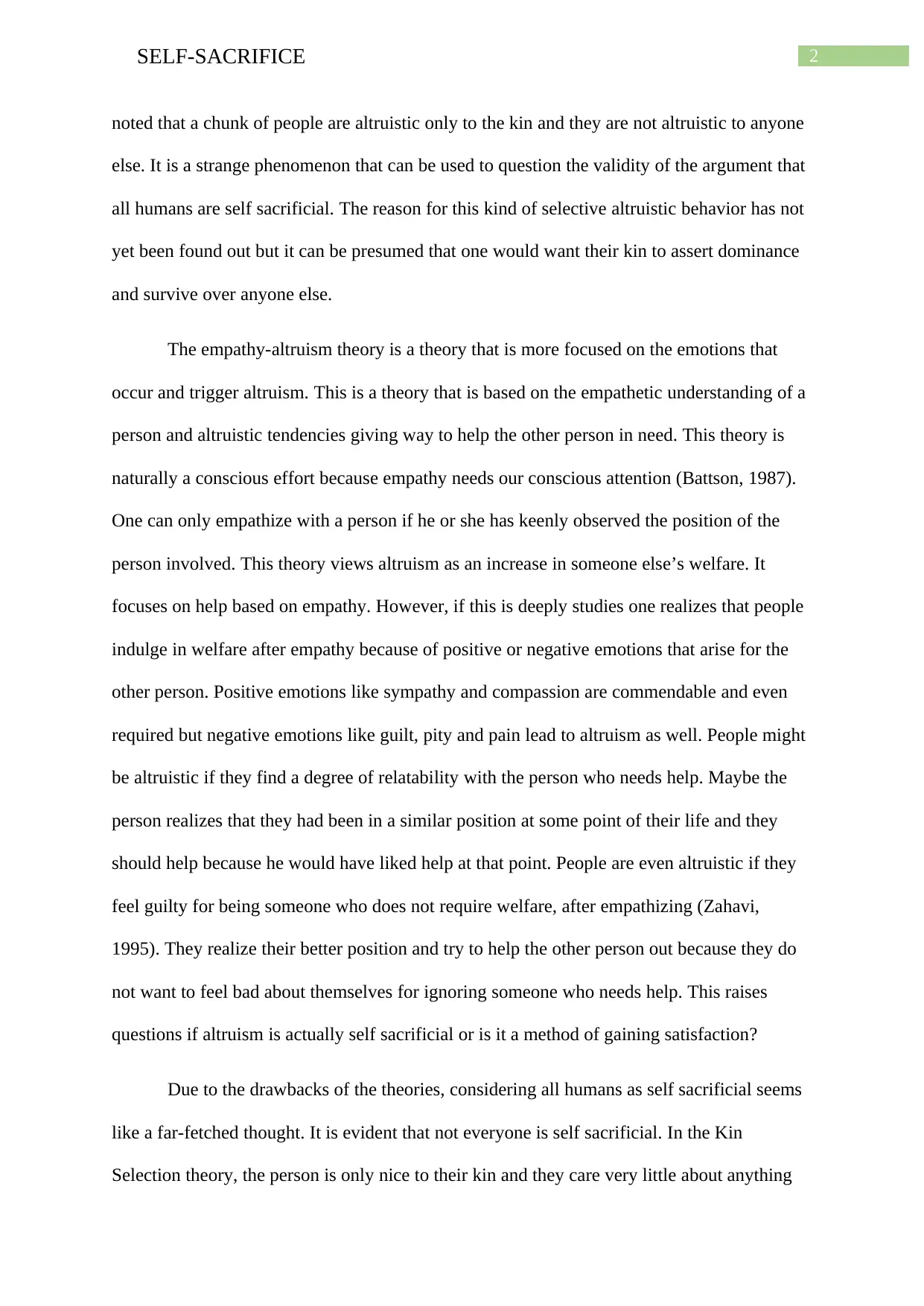
2SELF-SACRIFICE
noted that a chunk of people are altruistic only to the kin and they are not altruistic to anyone
else. It is a strange phenomenon that can be used to question the validity of the argument that
all humans are self sacrificial. The reason for this kind of selective altruistic behavior has not
yet been found out but it can be presumed that one would want their kin to assert dominance
and survive over anyone else.
The empathy-altruism theory is a theory that is more focused on the emotions that
occur and trigger altruism. This is a theory that is based on the empathetic understanding of a
person and altruistic tendencies giving way to help the other person in need. This theory is
naturally a conscious effort because empathy needs our conscious attention (Battson, 1987).
One can only empathize with a person if he or she has keenly observed the position of the
person involved. This theory views altruism as an increase in someone else’s welfare. It
focuses on help based on empathy. However, if this is deeply studies one realizes that people
indulge in welfare after empathy because of positive or negative emotions that arise for the
other person. Positive emotions like sympathy and compassion are commendable and even
required but negative emotions like guilt, pity and pain lead to altruism as well. People might
be altruistic if they find a degree of relatability with the person who needs help. Maybe the
person realizes that they had been in a similar position at some point of their life and they
should help because he would have liked help at that point. People are even altruistic if they
feel guilty for being someone who does not require welfare, after empathizing (Zahavi,
1995). They realize their better position and try to help the other person out because they do
not want to feel bad about themselves for ignoring someone who needs help. This raises
questions if altruism is actually self sacrificial or is it a method of gaining satisfaction?
Due to the drawbacks of the theories, considering all humans as self sacrificial seems
like a far-fetched thought. It is evident that not everyone is self sacrificial. In the Kin
Selection theory, the person is only nice to their kin and they care very little about anything
noted that a chunk of people are altruistic only to the kin and they are not altruistic to anyone
else. It is a strange phenomenon that can be used to question the validity of the argument that
all humans are self sacrificial. The reason for this kind of selective altruistic behavior has not
yet been found out but it can be presumed that one would want their kin to assert dominance
and survive over anyone else.
The empathy-altruism theory is a theory that is more focused on the emotions that
occur and trigger altruism. This is a theory that is based on the empathetic understanding of a
person and altruistic tendencies giving way to help the other person in need. This theory is
naturally a conscious effort because empathy needs our conscious attention (Battson, 1987).
One can only empathize with a person if he or she has keenly observed the position of the
person involved. This theory views altruism as an increase in someone else’s welfare. It
focuses on help based on empathy. However, if this is deeply studies one realizes that people
indulge in welfare after empathy because of positive or negative emotions that arise for the
other person. Positive emotions like sympathy and compassion are commendable and even
required but negative emotions like guilt, pity and pain lead to altruism as well. People might
be altruistic if they find a degree of relatability with the person who needs help. Maybe the
person realizes that they had been in a similar position at some point of their life and they
should help because he would have liked help at that point. People are even altruistic if they
feel guilty for being someone who does not require welfare, after empathizing (Zahavi,
1995). They realize their better position and try to help the other person out because they do
not want to feel bad about themselves for ignoring someone who needs help. This raises
questions if altruism is actually self sacrificial or is it a method of gaining satisfaction?
Due to the drawbacks of the theories, considering all humans as self sacrificial seems
like a far-fetched thought. It is evident that not everyone is self sacrificial. In the Kin
Selection theory, the person is only nice to their kin and they care very little about anything
⊘ This is a preview!⊘
Do you want full access?
Subscribe today to unlock all pages.

Trusted by 1+ million students worldwide
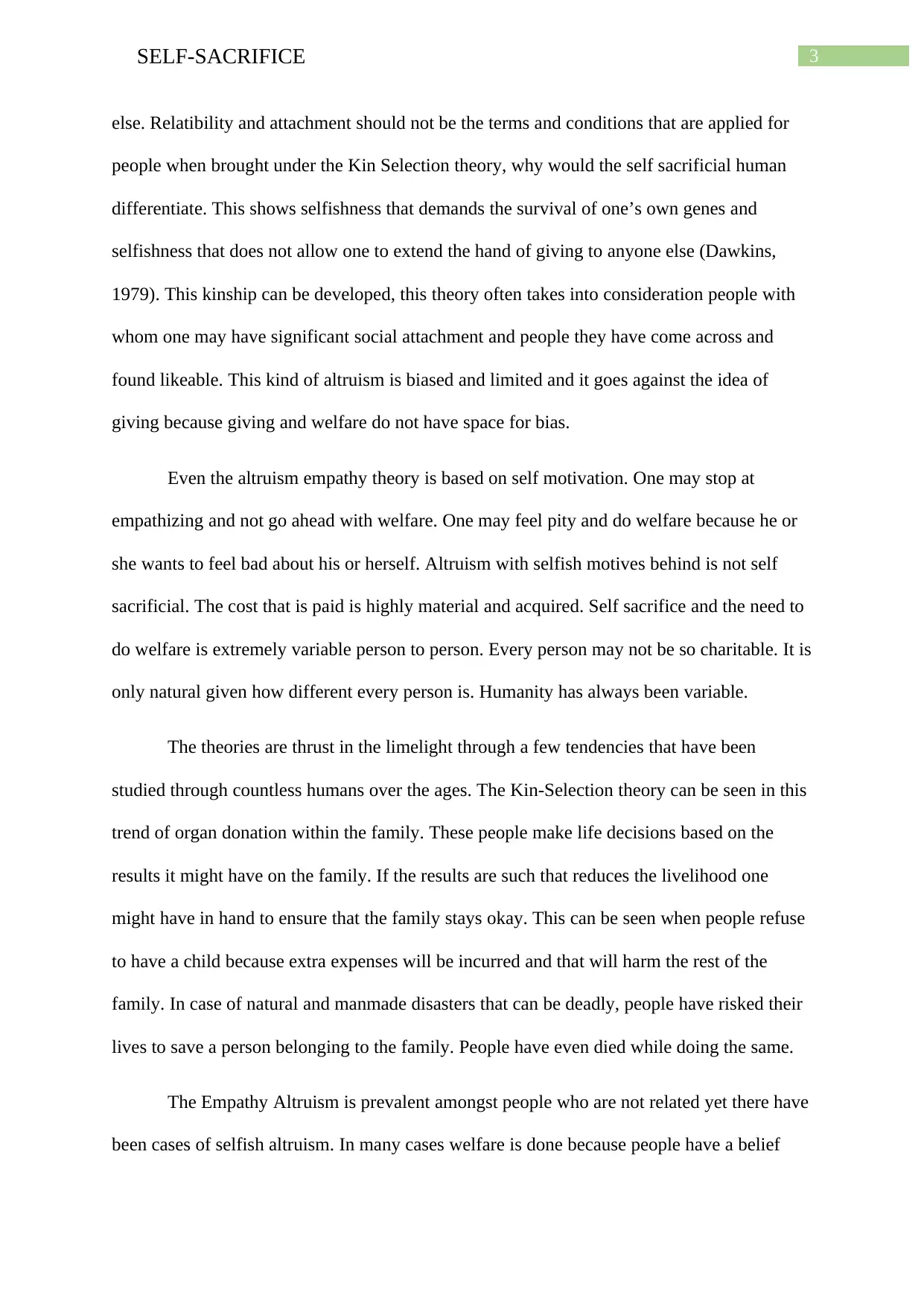
3SELF-SACRIFICE
else. Relatibility and attachment should not be the terms and conditions that are applied for
people when brought under the Kin Selection theory, why would the self sacrificial human
differentiate. This shows selfishness that demands the survival of one’s own genes and
selfishness that does not allow one to extend the hand of giving to anyone else (Dawkins,
1979). This kinship can be developed, this theory often takes into consideration people with
whom one may have significant social attachment and people they have come across and
found likeable. This kind of altruism is biased and limited and it goes against the idea of
giving because giving and welfare do not have space for bias.
Even the altruism empathy theory is based on self motivation. One may stop at
empathizing and not go ahead with welfare. One may feel pity and do welfare because he or
she wants to feel bad about his or herself. Altruism with selfish motives behind is not self
sacrificial. The cost that is paid is highly material and acquired. Self sacrifice and the need to
do welfare is extremely variable person to person. Every person may not be so charitable. It is
only natural given how different every person is. Humanity has always been variable.
The theories are thrust in the limelight through a few tendencies that have been
studied through countless humans over the ages. The Kin-Selection theory can be seen in this
trend of organ donation within the family. These people make life decisions based on the
results it might have on the family. If the results are such that reduces the livelihood one
might have in hand to ensure that the family stays okay. This can be seen when people refuse
to have a child because extra expenses will be incurred and that will harm the rest of the
family. In case of natural and manmade disasters that can be deadly, people have risked their
lives to save a person belonging to the family. People have even died while doing the same.
The Empathy Altruism is prevalent amongst people who are not related yet there have
been cases of selfish altruism. In many cases welfare is done because people have a belief
else. Relatibility and attachment should not be the terms and conditions that are applied for
people when brought under the Kin Selection theory, why would the self sacrificial human
differentiate. This shows selfishness that demands the survival of one’s own genes and
selfishness that does not allow one to extend the hand of giving to anyone else (Dawkins,
1979). This kinship can be developed, this theory often takes into consideration people with
whom one may have significant social attachment and people they have come across and
found likeable. This kind of altruism is biased and limited and it goes against the idea of
giving because giving and welfare do not have space for bias.
Even the altruism empathy theory is based on self motivation. One may stop at
empathizing and not go ahead with welfare. One may feel pity and do welfare because he or
she wants to feel bad about his or herself. Altruism with selfish motives behind is not self
sacrificial. The cost that is paid is highly material and acquired. Self sacrifice and the need to
do welfare is extremely variable person to person. Every person may not be so charitable. It is
only natural given how different every person is. Humanity has always been variable.
The theories are thrust in the limelight through a few tendencies that have been
studied through countless humans over the ages. The Kin-Selection theory can be seen in this
trend of organ donation within the family. These people make life decisions based on the
results it might have on the family. If the results are such that reduces the livelihood one
might have in hand to ensure that the family stays okay. This can be seen when people refuse
to have a child because extra expenses will be incurred and that will harm the rest of the
family. In case of natural and manmade disasters that can be deadly, people have risked their
lives to save a person belonging to the family. People have even died while doing the same.
The Empathy Altruism is prevalent amongst people who are not related yet there have
been cases of selfish altruism. In many cases welfare is done because people have a belief
Paraphrase This Document
Need a fresh take? Get an instant paraphrase of this document with our AI Paraphraser
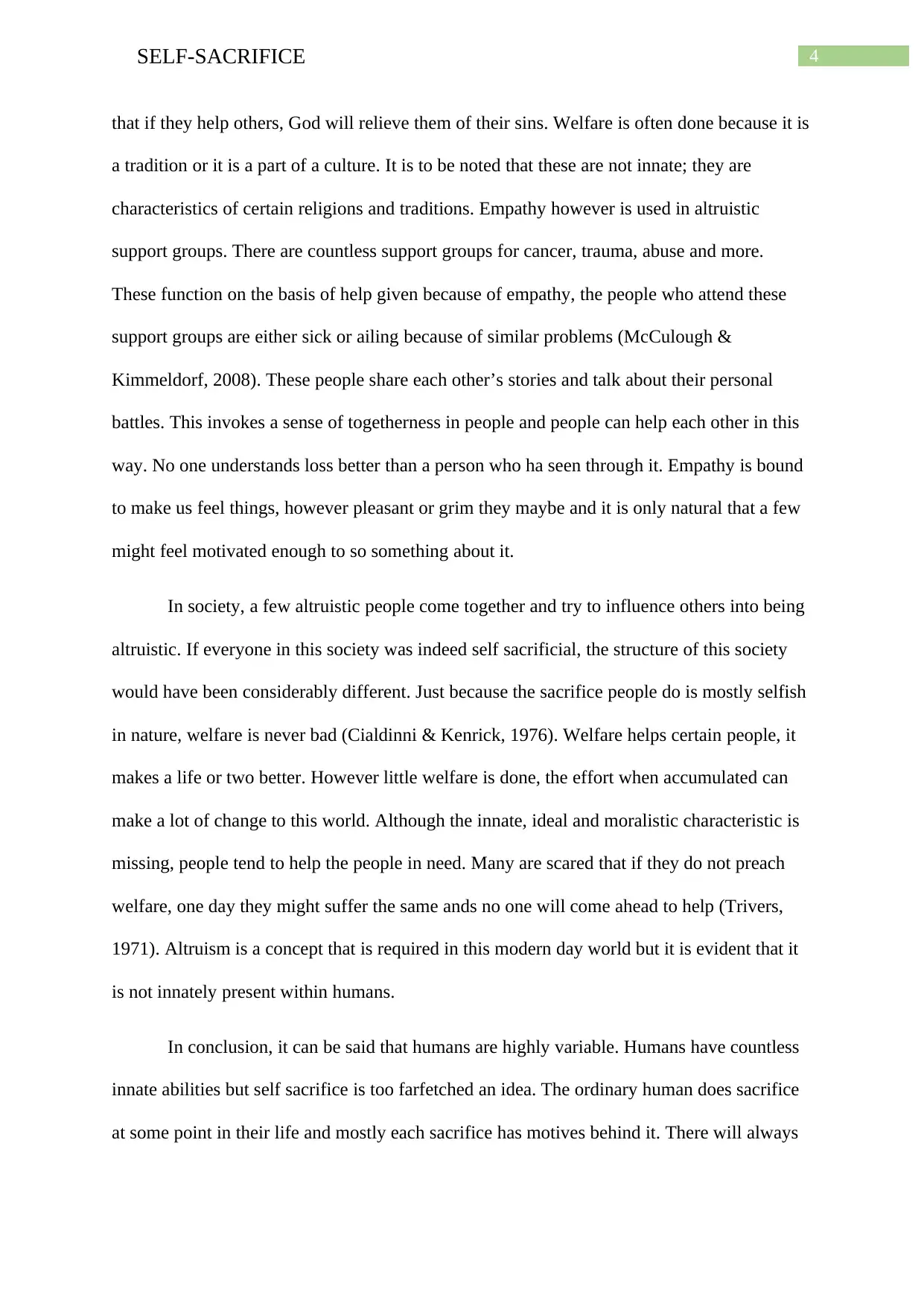
4SELF-SACRIFICE
that if they help others, God will relieve them of their sins. Welfare is often done because it is
a tradition or it is a part of a culture. It is to be noted that these are not innate; they are
characteristics of certain religions and traditions. Empathy however is used in altruistic
support groups. There are countless support groups for cancer, trauma, abuse and more.
These function on the basis of help given because of empathy, the people who attend these
support groups are either sick or ailing because of similar problems (McCulough &
Kimmeldorf, 2008). These people share each other’s stories and talk about their personal
battles. This invokes a sense of togetherness in people and people can help each other in this
way. No one understands loss better than a person who ha seen through it. Empathy is bound
to make us feel things, however pleasant or grim they maybe and it is only natural that a few
might feel motivated enough to so something about it.
In society, a few altruistic people come together and try to influence others into being
altruistic. If everyone in this society was indeed self sacrificial, the structure of this society
would have been considerably different. Just because the sacrifice people do is mostly selfish
in nature, welfare is never bad (Cialdinni & Kenrick, 1976). Welfare helps certain people, it
makes a life or two better. However little welfare is done, the effort when accumulated can
make a lot of change to this world. Although the innate, ideal and moralistic characteristic is
missing, people tend to help the people in need. Many are scared that if they do not preach
welfare, one day they might suffer the same ands no one will come ahead to help (Trivers,
1971). Altruism is a concept that is required in this modern day world but it is evident that it
is not innately present within humans.
In conclusion, it can be said that humans are highly variable. Humans have countless
innate abilities but self sacrifice is too farfetched an idea. The ordinary human does sacrifice
at some point in their life and mostly each sacrifice has motives behind it. There will always
that if they help others, God will relieve them of their sins. Welfare is often done because it is
a tradition or it is a part of a culture. It is to be noted that these are not innate; they are
characteristics of certain religions and traditions. Empathy however is used in altruistic
support groups. There are countless support groups for cancer, trauma, abuse and more.
These function on the basis of help given because of empathy, the people who attend these
support groups are either sick or ailing because of similar problems (McCulough &
Kimmeldorf, 2008). These people share each other’s stories and talk about their personal
battles. This invokes a sense of togetherness in people and people can help each other in this
way. No one understands loss better than a person who ha seen through it. Empathy is bound
to make us feel things, however pleasant or grim they maybe and it is only natural that a few
might feel motivated enough to so something about it.
In society, a few altruistic people come together and try to influence others into being
altruistic. If everyone in this society was indeed self sacrificial, the structure of this society
would have been considerably different. Just because the sacrifice people do is mostly selfish
in nature, welfare is never bad (Cialdinni & Kenrick, 1976). Welfare helps certain people, it
makes a life or two better. However little welfare is done, the effort when accumulated can
make a lot of change to this world. Although the innate, ideal and moralistic characteristic is
missing, people tend to help the people in need. Many are scared that if they do not preach
welfare, one day they might suffer the same ands no one will come ahead to help (Trivers,
1971). Altruism is a concept that is required in this modern day world but it is evident that it
is not innately present within humans.
In conclusion, it can be said that humans are highly variable. Humans have countless
innate abilities but self sacrifice is too farfetched an idea. The ordinary human does sacrifice
at some point in their life and mostly each sacrifice has motives behind it. There will always

5SELF-SACRIFICE
be people who will be altruistic in nature in countless ways and will always be influencing
others to be the same.
be people who will be altruistic in nature in countless ways and will always be influencing
others to be the same.
⊘ This is a preview!⊘
Do you want full access?
Subscribe today to unlock all pages.

Trusted by 1+ million students worldwide
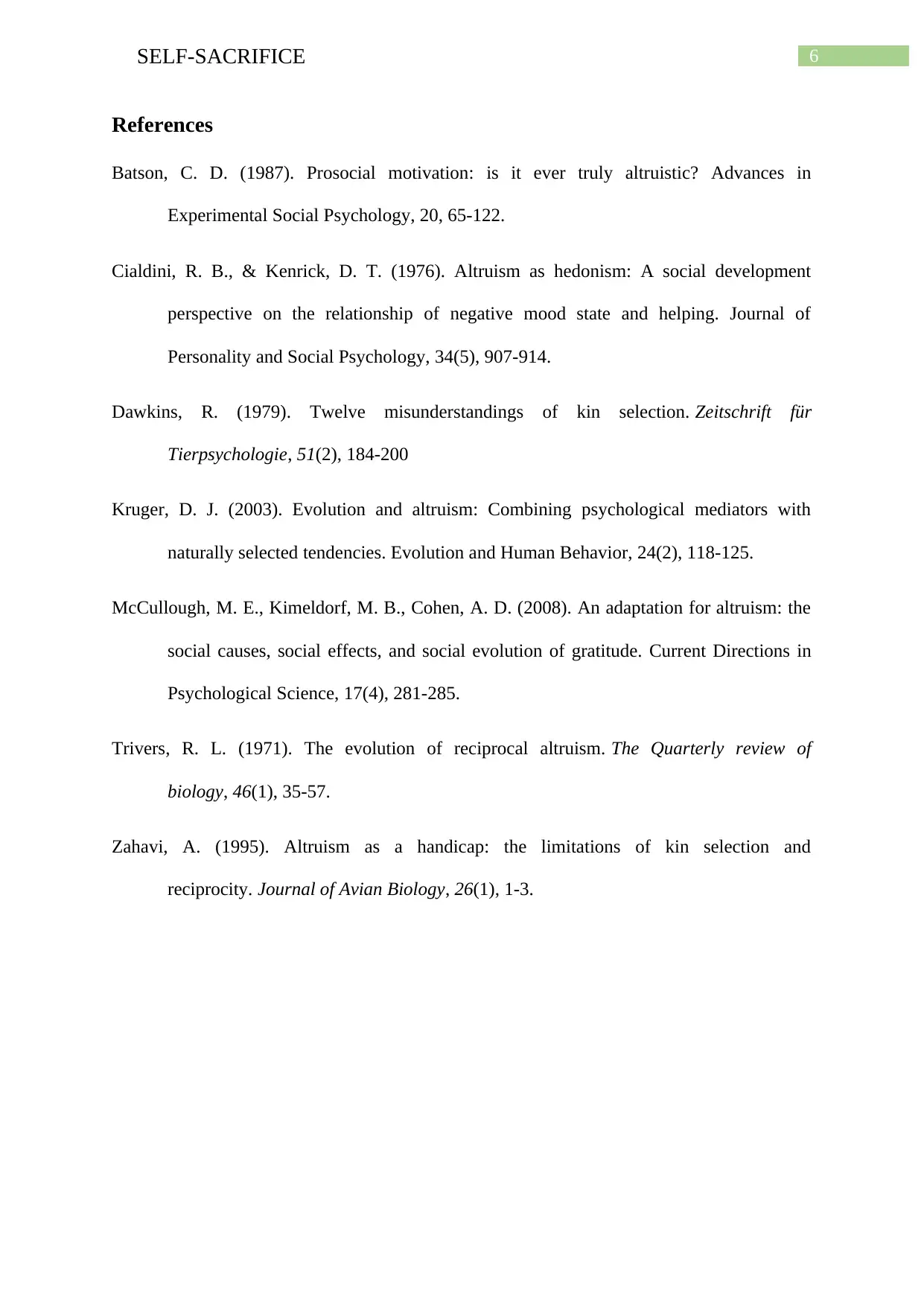
6SELF-SACRIFICE
References
Batson, C. D. (1987). Prosocial motivation: is it ever truly altruistic? Advances in
Experimental Social Psychology, 20, 65-122.
Cialdini, R. B., & Kenrick, D. T. (1976). Altruism as hedonism: A social development
perspective on the relationship of negative mood state and helping. Journal of
Personality and Social Psychology, 34(5), 907-914.
Dawkins, R. (1979). Twelve misunderstandings of kin selection. Zeitschrift für
Tierpsychologie, 51(2), 184-200
Kruger, D. J. (2003). Evolution and altruism: Combining psychological mediators with
naturally selected tendencies. Evolution and Human Behavior, 24(2), 118-125.
McCullough, M. E., Kimeldorf, M. B., Cohen, A. D. (2008). An adaptation for altruism: the
social causes, social effects, and social evolution of gratitude. Current Directions in
Psychological Science, 17(4), 281-285.
Trivers, R. L. (1971). The evolution of reciprocal altruism. The Quarterly review of
biology, 46(1), 35-57.
Zahavi, A. (1995). Altruism as a handicap: the limitations of kin selection and
reciprocity. Journal of Avian Biology, 26(1), 1-3.
References
Batson, C. D. (1987). Prosocial motivation: is it ever truly altruistic? Advances in
Experimental Social Psychology, 20, 65-122.
Cialdini, R. B., & Kenrick, D. T. (1976). Altruism as hedonism: A social development
perspective on the relationship of negative mood state and helping. Journal of
Personality and Social Psychology, 34(5), 907-914.
Dawkins, R. (1979). Twelve misunderstandings of kin selection. Zeitschrift für
Tierpsychologie, 51(2), 184-200
Kruger, D. J. (2003). Evolution and altruism: Combining psychological mediators with
naturally selected tendencies. Evolution and Human Behavior, 24(2), 118-125.
McCullough, M. E., Kimeldorf, M. B., Cohen, A. D. (2008). An adaptation for altruism: the
social causes, social effects, and social evolution of gratitude. Current Directions in
Psychological Science, 17(4), 281-285.
Trivers, R. L. (1971). The evolution of reciprocal altruism. The Quarterly review of
biology, 46(1), 35-57.
Zahavi, A. (1995). Altruism as a handicap: the limitations of kin selection and
reciprocity. Journal of Avian Biology, 26(1), 1-3.
1 out of 7
Your All-in-One AI-Powered Toolkit for Academic Success.
+13062052269
info@desklib.com
Available 24*7 on WhatsApp / Email
![[object Object]](/_next/static/media/star-bottom.7253800d.svg)
Unlock your academic potential
© 2024 | Zucol Services PVT LTD | All rights reserved.


